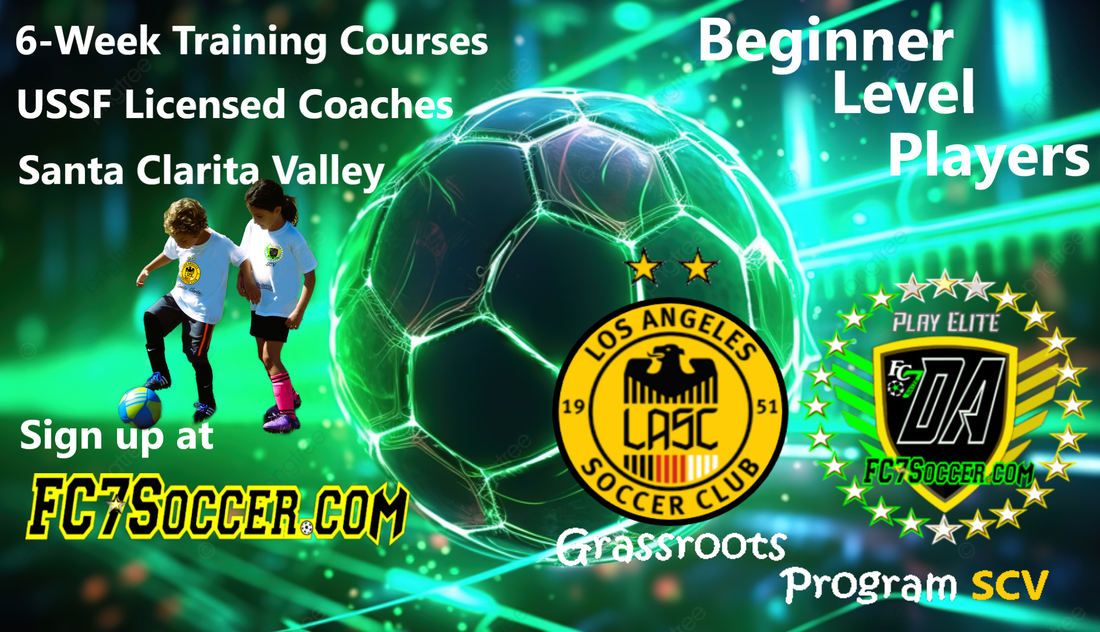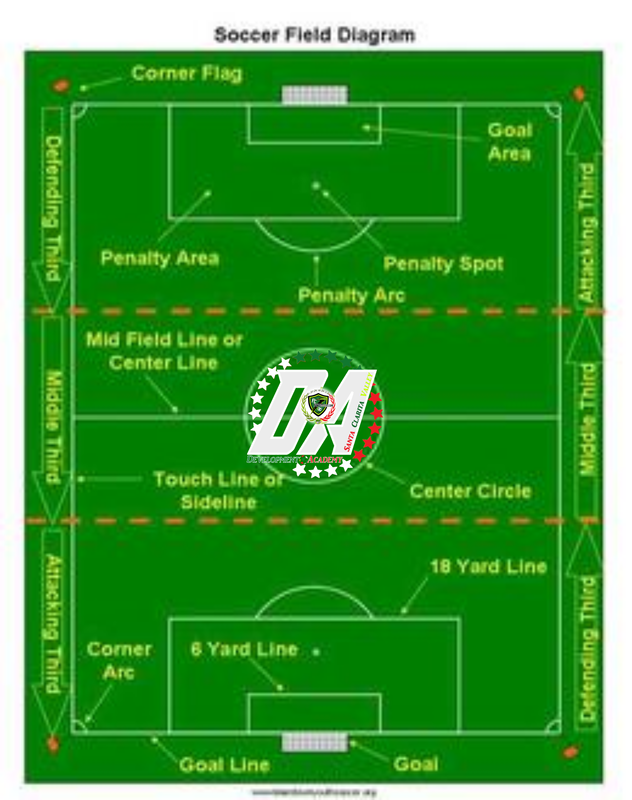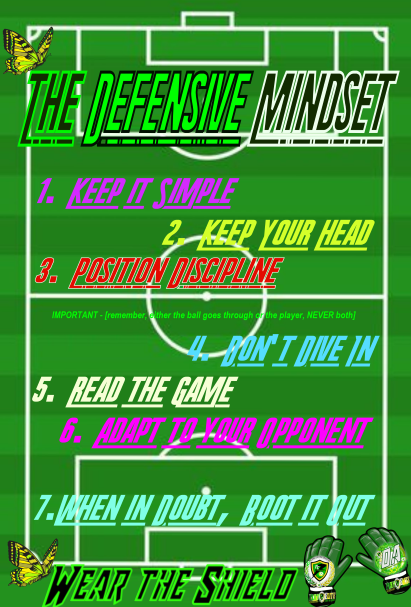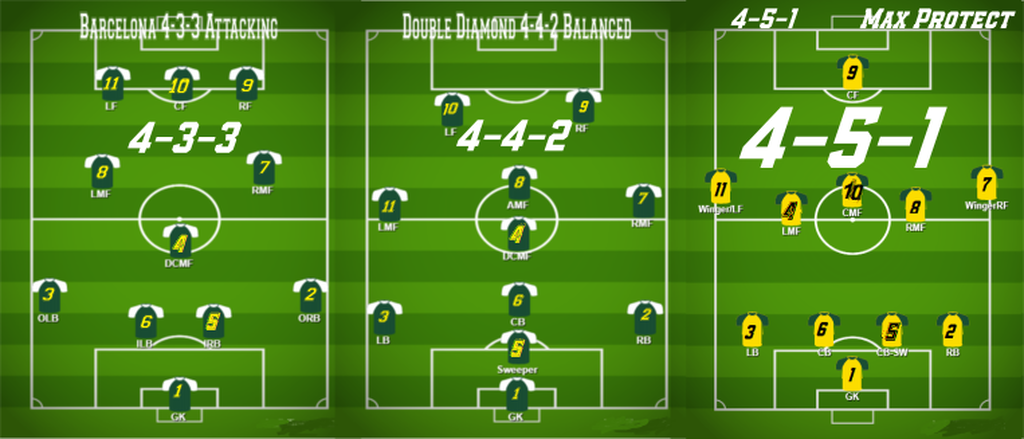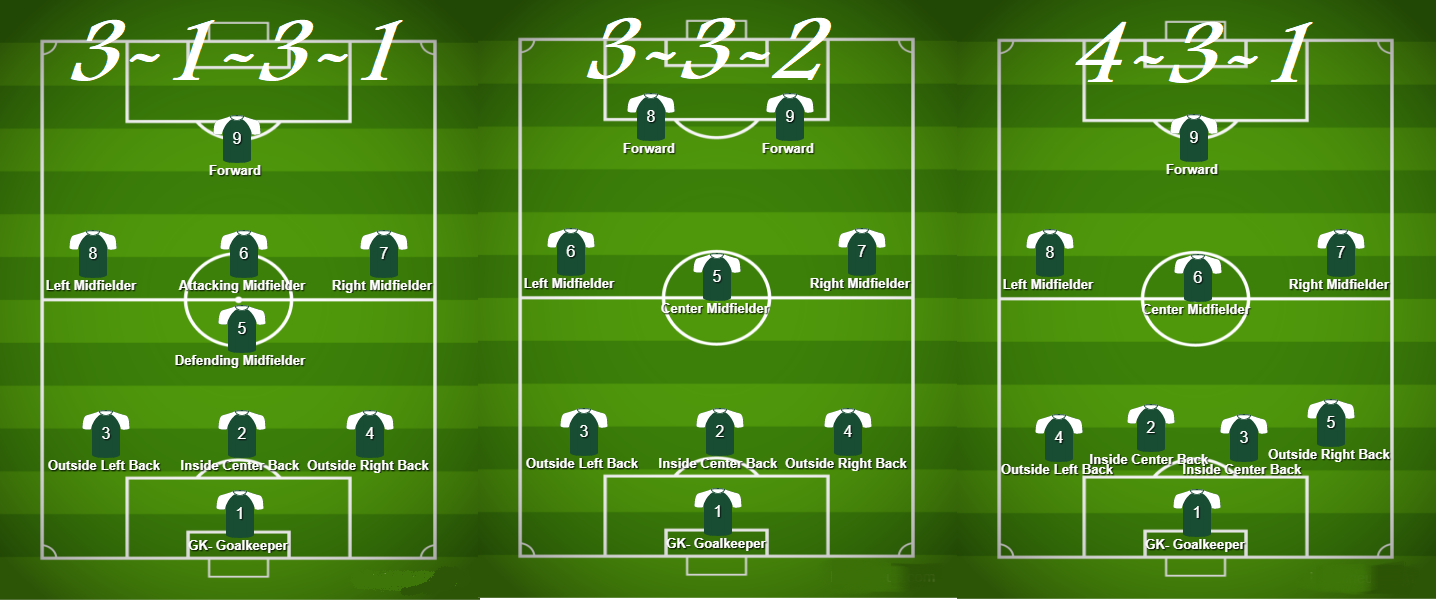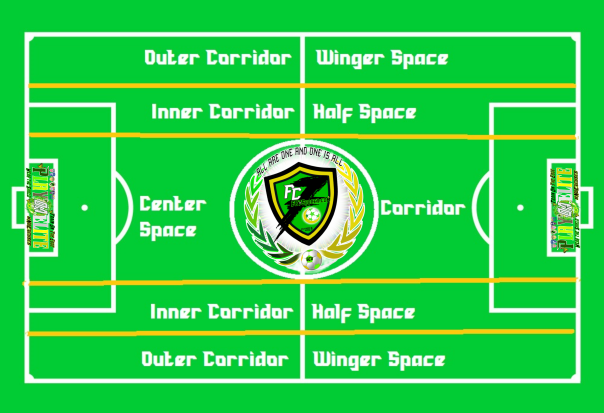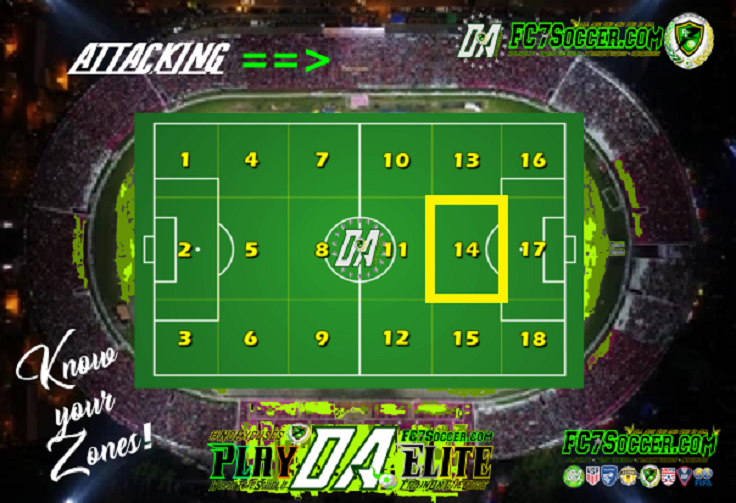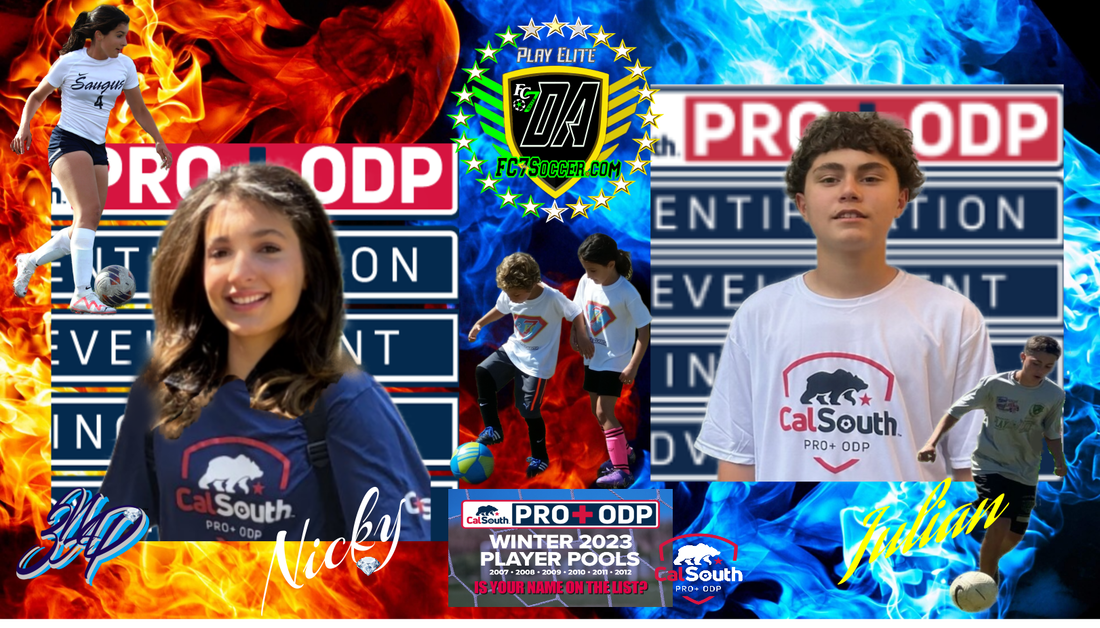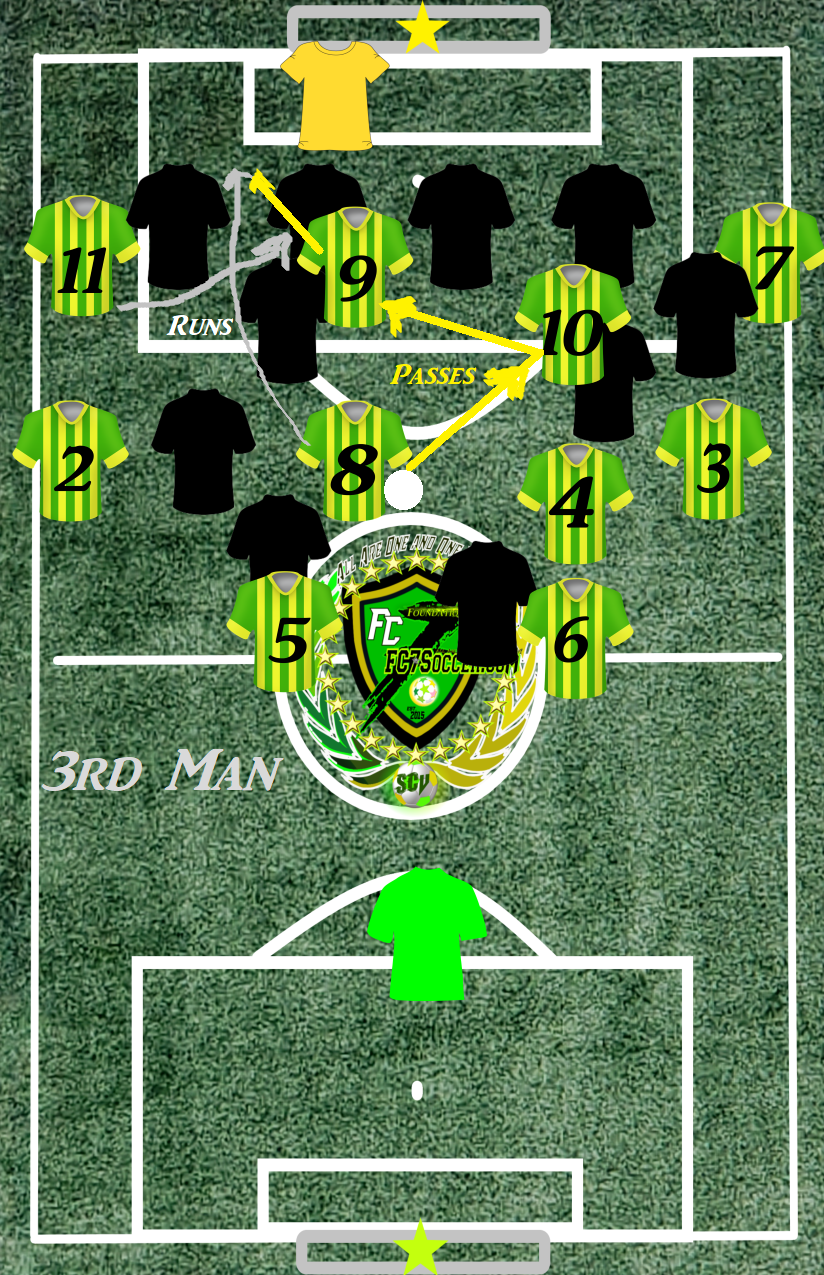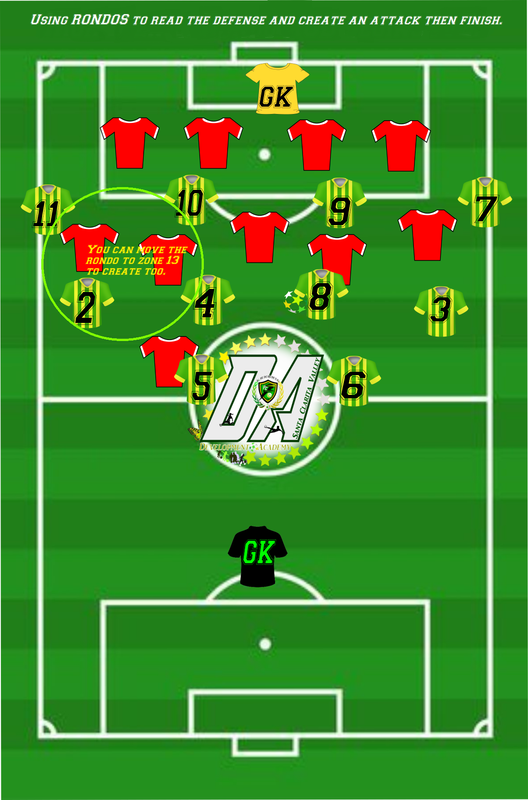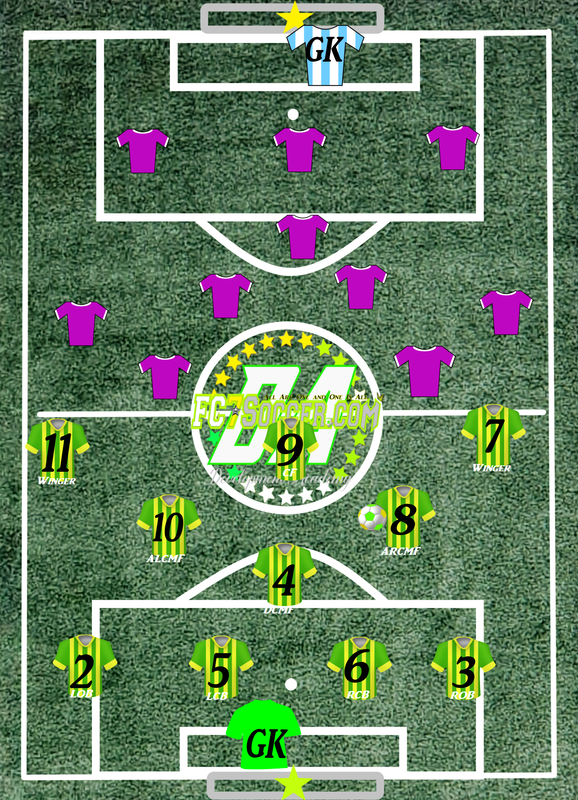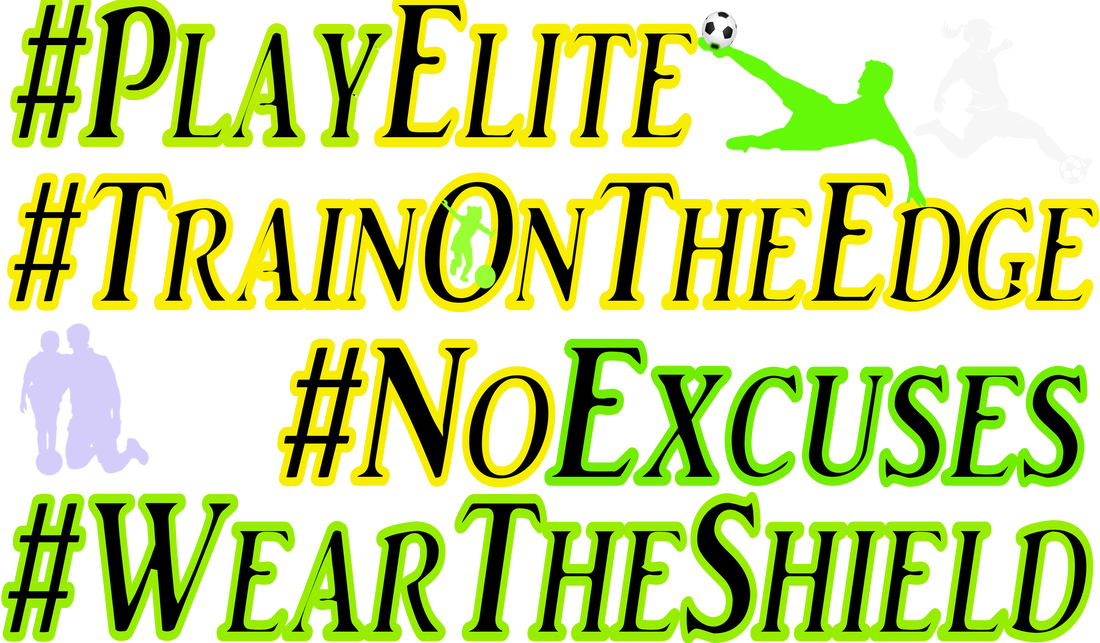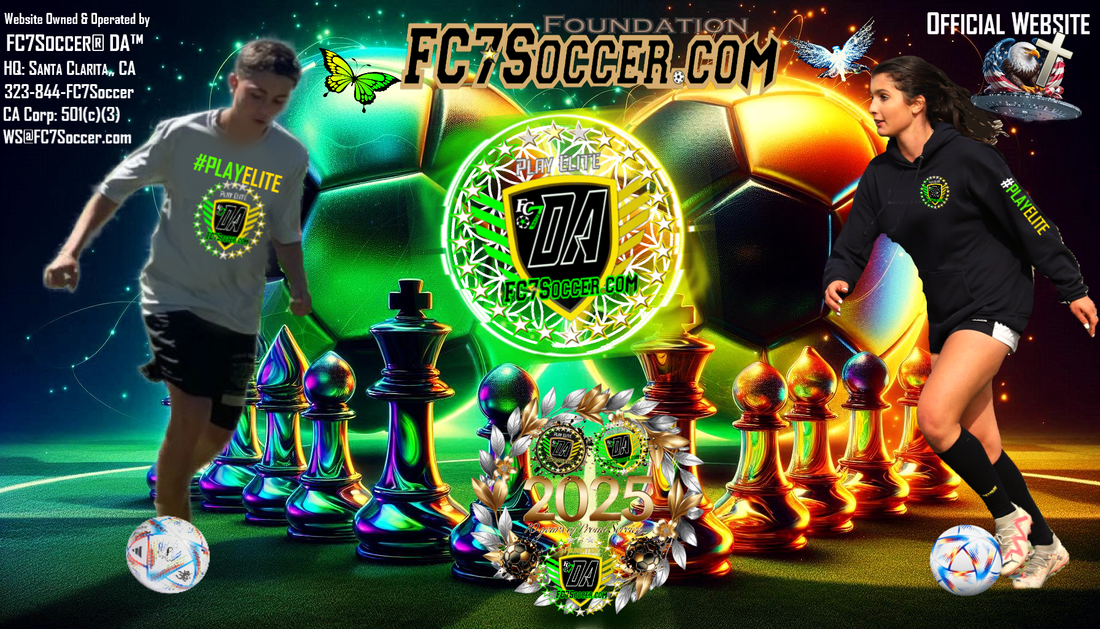The Study Page - Knowledgebase; Table of Contents
Section 1: Game laws, structure, key elements and other important acumen.
Section 2: The Play (playbook), Set Pieces; diagrams for offense and defense.
Section 1: Game laws, structure, key elements and other important acumen.
Section 2: The Play (playbook), Set Pieces; diagrams for offense and defense.
"Control what you can control with maximum effort."

At FC7Soccer® we want all players to be prepared for life. Our Training Library helps us teach players how to prepare for soccer using similar preparation frameworks as in business and in life experiences.
Players, let your parents know this. We ask that all of our parents commit to helping players learn smart study habits and to do the work every night. We have assembled videos, pdfs, images, and other resources for our players to study and learn from on their off days. We know the habits they learn now will carry with them throughout their lives.
We want our players to understand the importance of evidence, forensics, scholarly work, and the scientific method of gathering truthful data. To put in the work rather than creating anecdotes that marginalize truthfulness ... creates doubt in one's character. We want each of you to put in maximum effort and take calculated risks based on truthful facts so that when you succeed or fail, you learn, and when you fail, you fail fast and recover swiftly, learning from your mistakes. Know that making mistakes is an important piece in building your soccer-IQ. You can only be successful with trust and belief in yourself [that is your foundation to build on], know how to respond (not react) and recover during/after a mistake. Control the game within the game (your passion/emotions). Belief in yourself comes from always telling yourself the truth (authenticity) and gaining trust by knowing your strengths/weaknesses. Work ... with full effort and the data you have to make the most of your experiences and keep a growth mindset. Iterate continuously. Fail fast by recognizing it right away then learning from it and move past it. Great athletes are great because they are humble and are not afraid to fail. They push almost to failure, learn fast, and move past every failure. To them they are lessons not mistakes. Lastly ... Always be ready to serve to others without judgement to ensure everyone's success and when it's that time, be sure to give back what was given to you for the next generation. Be a true leader. Thank you. -FC7Soccer® Management
Players, let your parents know this. We ask that all of our parents commit to helping players learn smart study habits and to do the work every night. We have assembled videos, pdfs, images, and other resources for our players to study and learn from on their off days. We know the habits they learn now will carry with them throughout their lives.
We want our players to understand the importance of evidence, forensics, scholarly work, and the scientific method of gathering truthful data. To put in the work rather than creating anecdotes that marginalize truthfulness ... creates doubt in one's character. We want each of you to put in maximum effort and take calculated risks based on truthful facts so that when you succeed or fail, you learn, and when you fail, you fail fast and recover swiftly, learning from your mistakes. Know that making mistakes is an important piece in building your soccer-IQ. You can only be successful with trust and belief in yourself [that is your foundation to build on], know how to respond (not react) and recover during/after a mistake. Control the game within the game (your passion/emotions). Belief in yourself comes from always telling yourself the truth (authenticity) and gaining trust by knowing your strengths/weaknesses. Work ... with full effort and the data you have to make the most of your experiences and keep a growth mindset. Iterate continuously. Fail fast by recognizing it right away then learning from it and move past it. Great athletes are great because they are humble and are not afraid to fail. They push almost to failure, learn fast, and move past every failure. To them they are lessons not mistakes. Lastly ... Always be ready to serve to others without judgement to ensure everyone's success and when it's that time, be sure to give back what was given to you for the next generation. Be a true leader. Thank you. -FC7Soccer® Management
| ||||||||
|
On DEFENSE: its important to know terms like slide, trap, and push to the line, DCM-6, Sweeper-4, fullback 4-5, man-marking, body them, build out of the back, slide tackle, "double trap", step, hold the line, and know how to protect the GK. You should also know how to play an outside back role 2-3. Most importantly: ...either the man gets through or the ball -never both!
18 Laws of Youth Soccer
Zones - Corridors- Pitch Mindset.
|
ATTACKING: Be sure you know when/how to show, what a "45" is, overlaps-underlaps, back post, front post, "rule of 3s", diamond-triangle rondos with angle run-throughs, header-flick, volley, one-touch or one-time, cross, dummy, set-piece, zone 14, scan-read-respond, pass throughs, switch the field, know the midfield is responsible to keep the front and back connected, finish, penetrate, attack, pace, tempo, pitch, match, create opportunities, be sure you know who Johann Cryuff is and what his philosophy and formation is/does.
 FC7Soccer® "The Offensive Mindset" - Play Elite FC7Soccer® "The Offensive Mindset" - Play Elite
| ||||||||||||||||||||
⚽Scroll down to SECTION II for the Playbook by FC7Soccer® ⚽
|
Full Field Top Formations [U12+] - 11 v 11 by FC7Soccer®
|
Top 9 player formations in soccer for our club teams
|
On the Pitch: The 5 Corridors and the 18 Zones
🏆TOUCHES (rule of thumb mindset): ⚽One if you can -⚽Two if you have to -⚽Three if you must.
⚽💕🏆Most club players will never get to the next level or even be considered. The reason .. they struggle on the pitch, fighting between technique and passion. - Coach CW Pickering
⚽Our number one expectation is commitment. To play with us you have to make a commitment to yourself and to the team. You will be conditioning, training, and studying. Your technique matters .. know it second nature. Conditioning is fundamental to soccer. When you practice like it's the championship match, you are training elite and your experiences give you the most value on the pitch.
You should always come to play with passion. Give maximum effort and never be outworked. You should train on your off days like it is game day. You should practice like it's the playoffs and play each game like it is the championship. That is commitment. Also remember speed is different than quickness. Quickness is recognition and response (not reaction) while taking action on the read. Speed can be great but quickness is a game changer. Timing too. Be quick with timing in your commitment. Don't fear taking action ... trust the read ... so always be scanning-read/respond- move into the next position for support ... exceed expectations.🏆
You should always come to play with passion. Give maximum effort and never be outworked. You should train on your off days like it is game day. You should practice like it's the playoffs and play each game like it is the championship. That is commitment. Also remember speed is different than quickness. Quickness is recognition and response (not reaction) while taking action on the read. Speed can be great but quickness is a game changer. Timing too. Be quick with timing in your commitment. Don't fear taking action ... trust the read ... so always be scanning-read/respond- move into the next position for support ... exceed expectations.🏆
PlayElite: The FC7Soccer® Playbook [the play]⚽is to give our players early knowledge of how the game is played best on the attack from building out of the back to midfield read-response and into various set pieces where you penetrate, attack, and finish. It gives our players a fallback to create from should they feel lost in a match, scrimmage, or at practice when on the attack. It allows new players to work through a process similar to set pieces and learn how we attack and finish starting from the back. It helps all players understand each other first, then shape, support, reading, showing, passing, run making, and how to create the matchups to finish and not to panic, but how to respond and not react, along with scanning so that they thinking ahead.
Soccer game play flow processes work best with small-sided game and rondo-style support. Learning attack shapes (rondos-runs-crosses-service) are substructure workflows to creating matchup problems when you attack and finish in the beautiful game. Our playbook is merely one of many ways to create the structure-work flows-matchup issues that give you an advantage on the attacking side. Your own technical skill with tactics intelligence will bring forth the ability to create opportunities when you follow our workflow structure.
The Playbook is a foundational resource from what our players use to build upon and become a tight knit team who loves finishing and winning together. Nothing replaces experience and the creativity of playing/working together, responding/showing/passing/finishing in the moment based on your reads, scanning, moving to see the numbers around the box and to know where you can exploit and then pass, dribble, or show for the ball and use angle run fractal flows to finish. We encourage our players to play with friends and teammates on off days to enhance their creative insight for learning the art of game play together in a moment-to-moment setting (on the edge) and honing the details (technique, scanning, ball mastery, passing, showing, responding, finishing, and defensive tactics like slide tackles, switching, trapping/double-trap, stepping, and anticipating) in their soccer IQ/game play and teamwork.
Soccer game play flow processes work best with small-sided game and rondo-style support. Learning attack shapes (rondos-runs-crosses-service) are substructure workflows to creating matchup problems when you attack and finish in the beautiful game. Our playbook is merely one of many ways to create the structure-work flows-matchup issues that give you an advantage on the attacking side. Your own technical skill with tactics intelligence will bring forth the ability to create opportunities when you follow our workflow structure.
The Playbook is a foundational resource from what our players use to build upon and become a tight knit team who loves finishing and winning together. Nothing replaces experience and the creativity of playing/working together, responding/showing/passing/finishing in the moment based on your reads, scanning, moving to see the numbers around the box and to know where you can exploit and then pass, dribble, or show for the ball and use angle run fractal flows to finish. We encourage our players to play with friends and teammates on off days to enhance their creative insight for learning the art of game play together in a moment-to-moment setting (on the edge) and honing the details (technique, scanning, ball mastery, passing, showing, responding, finishing, and defensive tactics like slide tackles, switching, trapping/double-trap, stepping, and anticipating) in their soccer IQ/game play and teamwork.
The 3 key pieces in developing a young player are: TECHNIQUE, TIMING, and VISION. At home, start with footwork and ball mastery technique daily (touches-various dribbles-passing and move: showing/receiving, 1-touch passes, rondo: triangle/diamonds and runs off of them but keeping your shape/space, also shooting with both feet, and defensive tactics). Next work on your timing for attacking (with someone): runs into space to show and ask for the ball. Point to where you want it and be specific, passing into space (look for the pockets forming and rondos), quick shape support rondos, change of speed/direction, pass-through and transition runs and go into shooting/finishing drills off a pass .. find your key areas on the field and how the defense is playing those areas (what zones?) by scanning consistency. Then, work on your defensive timing: anticipate-press-when to double trap (team), when to step, or when to use slide tackles-etc.. Lastly know this.
Vision comes from/with experience, the more game play (especially at high-levels) will help you with your vision, anticipation, and your ability to predict. Seeing the holistic picture and predicting pockets, knowing when to pass-through, 1-touch show-rondos and move or when to quickly switch the field or intercept a ball on defense. Since finishing is the most difficult action to succeed at will will focus on attacking with vision for now. Knowing what defenders will do and predicting the right response/best action to take to ensure the right outcome is vision (like chess). The game is fluid because it is designed for you to be able to exploit and benefit from the opponents mistakes as their energy loss begins to affect their decision making. You do this from a midfield perch where you should always have the holistic perspective to think ahead by scanning/reading/problem solving to see the many opportunities and outcomes you can create ... it's like a general leading an army but in an instant. It is an enchanting power or magic that only the best of the best have mastered. It's swift and its ubiquitous for those chosen few ... it is vision.
Vision comes from/with experience, the more game play (especially at high-levels) will help you with your vision, anticipation, and your ability to predict. Seeing the holistic picture and predicting pockets, knowing when to pass-through, 1-touch show-rondos and move or when to quickly switch the field or intercept a ball on defense. Since finishing is the most difficult action to succeed at will will focus on attacking with vision for now. Knowing what defenders will do and predicting the right response/best action to take to ensure the right outcome is vision (like chess). The game is fluid because it is designed for you to be able to exploit and benefit from the opponents mistakes as their energy loss begins to affect their decision making. You do this from a midfield perch where you should always have the holistic perspective to think ahead by scanning/reading/problem solving to see the many opportunities and outcomes you can create ... it's like a general leading an army but in an instant. It is an enchanting power or magic that only the best of the best have mastered. It's swift and its ubiquitous for those chosen few ... it is vision.
Install Package: Building Out of the Back
⚽First four blueprints we call "THE PLAY": teach players how to think about building out of the back. Building out of the back is a loosly structured scheme used to win the midfield by reading, creating, penetrating, supporting, attacking, then finishing. The back third is low risk accurate passing with control, scanning, showing, and communicating. You show into rondos at the mid-third where you read/scheme, and create from your rondo-reads then move into penetration and an attack creativity. Smart players use 1-touch/2-touch passing penetration/support to break through the back-line in the attacking third where you wrap with a cross, angle run, or fake/move, and finish.⚽
⚽When there is no direct play, you build out of the back but your 6 and 8 have to be solid. The GK must read, find a good match-up, and direct traffic. The key when building in the back is low risk accurate passes and players sticking to that plan. All passes must be low risk and accurate with pace. knowing how/when to show and support making certain all is low risk is mission critical. Triangles/diamonds that quickly move the ball up into the outside midfield to read and develop plays swiftly for outside crosses or inside into zone 14 for swift attacking and finishing.
Play into the scheme and show with a change of speed or delayed fast movement and move into an open space or "the pocket" using timed anticipation runs from a pre-scan so you may already anticipate your next move with the ball or in rondo support if you don't get it. Scan so after you pass you know the space you need to fill. Use small/fast attack surface rondos shapes/one touch whenever possible paying attention to the rotation radius you receive the ball in after scanning then respond as the situation reads. This means as you receive the ball, open up your radius and leverage your body adversely to the defender. Use core rotation and leg mechanics as required to receive-pass-move or receive and attack swiftly. If while in the rondo it becomes over matched by the defense, you should switch the field by first playing the ball out of harms way to your support showing in the midfield. Play the ball back and across into another rondo on the other side or if a pass through opens up don't wait for permission. Then create based on the attack read and scheme into the set-piece or service play required by the read and match-up penetration thru to finish.⚽🏆
⚽When there is no direct play, you build out of the back but your 6 and 8 have to be solid. The GK must read, find a good match-up, and direct traffic. The key when building in the back is low risk accurate passes and players sticking to that plan. All passes must be low risk and accurate with pace. knowing how/when to show and support making certain all is low risk is mission critical. Triangles/diamonds that quickly move the ball up into the outside midfield to read and develop plays swiftly for outside crosses or inside into zone 14 for swift attacking and finishing.
Play into the scheme and show with a change of speed or delayed fast movement and move into an open space or "the pocket" using timed anticipation runs from a pre-scan so you may already anticipate your next move with the ball or in rondo support if you don't get it. Scan so after you pass you know the space you need to fill. Use small/fast attack surface rondos shapes/one touch whenever possible paying attention to the rotation radius you receive the ball in after scanning then respond as the situation reads. This means as you receive the ball, open up your radius and leverage your body adversely to the defender. Use core rotation and leg mechanics as required to receive-pass-move or receive and attack swiftly. If while in the rondo it becomes over matched by the defense, you should switch the field by first playing the ball out of harms way to your support showing in the midfield. Play the ball back and across into another rondo on the other side or if a pass through opens up don't wait for permission. Then create based on the attack read and scheme into the set-piece or service play required by the read and match-up penetration thru to finish.⚽🏆
|
|
|
|
|
✨In the 3rd graphic (above) you see a diamond rondo to help you win the midfield. You must step and show into the rondo diamond. Outside to inside should be the primary game play, but if it is not open, use the rondo scheme to read the defense and take what is given to you then create (maybe 1-2s up the winger corridor). Rondos (triangle/diamonds) should always be your "go to" for reading/scheming an attack and for support. You can create a fast moving attack by one touch passing to finish from the rondo scheme by reading the defense and moving into space (angles) while communicating, scanning, showing, and supporting without the ball so that the player with the ball may respond and pass/move off of their read quickly into pockets and zone where there are favorable match ups to penetrate and finish.⚽
Install Package: Playing Direct-GK plays direct to forwards.
⚽In the video, watch how the players show in the rondo for fast passing/attacking.🏆
Install Package: Midfield RONDOS for Building an Attack
⚽Rondos are a drill (Cryuff/Barca) that you can use in game play when in your triangle and diamond shapes (see video above). Like during the drill, the swift paced support on the pitch will help you read the defense to win the midfield and navigate an attack with favorable matchups and runs. Rondos are meant to be played at a high tempo with 1 touch (2-max) movement, in response after reading the defense (show/respond/pass/show) to attack an opponent, penetrate, then finish with pace. It is a read/show and respond movement ... do not just react to get rid of the ball Respond to your reads.⚽
Without the ball in the rondo you should be reading too, then showing and responding based on your read. Leverage the defender with your body position. Scan the defense, penetrate into pockets and show/step or make fast angle runs into space for finishing and helping your team. As the ball comes your way your response must be fast, accurate, and deliberate. Sometimes that means switching the field out of the rondo. Moving the ball back out for a reset can be a great option if penetration is blocked. When sliding into pockets to show, time it with a last second change of speed to receive it uncontested and continue the small sided game movement penetrating and passing the ball swiftly then finishing.
⚽Communicate and scan (shoulder check). If the ball doesn't come to you and you are nearby, be ready to move into a rondo and show with leverage to support the play in the zone the game play is moving into. Scan to read whats available before you move to show and receive the ball. If you have a favorable match-up, break into a set-piece, overlap, or 1-2s for penetration, service, and finishing. If you are the player creating service or crossing, pick a target. If you are one of the players making a run on a cross (or corner), stay in your lane, receive the cross and then finish-fast (head it). 🏆
Without the ball in the rondo you should be reading too, then showing and responding based on your read. Leverage the defender with your body position. Scan the defense, penetrate into pockets and show/step or make fast angle runs into space for finishing and helping your team. As the ball comes your way your response must be fast, accurate, and deliberate. Sometimes that means switching the field out of the rondo. Moving the ball back out for a reset can be a great option if penetration is blocked. When sliding into pockets to show, time it with a last second change of speed to receive it uncontested and continue the small sided game movement penetrating and passing the ball swiftly then finishing.
⚽Communicate and scan (shoulder check). If the ball doesn't come to you and you are nearby, be ready to move into a rondo and show with leverage to support the play in the zone the game play is moving into. Scan to read whats available before you move to show and receive the ball. If you have a favorable match-up, break into a set-piece, overlap, or 1-2s for penetration, service, and finishing. If you are the player creating service or crossing, pick a target. If you are one of the players making a run on a cross (or corner), stay in your lane, receive the cross and then finish-fast (head it). 🏆
ACMF-DCMF-CMF: Read the Defense to Create the Attack
|
The beautiful game is usually won in the midfield. ACMFs set the tone through reads for tempo, set pieces, and where the ball should go. The wingers and forwards must show in pockets and other midfielders and defenders must show behind in support. The ACMF must see the field both holistically and with intent to exploit matchups when in an attacking zone on the pitch. They rely on their teammates vision/soccer IQ to read and show for them into favorable matchup runs and support (after building out of the back or a direct play or maybe a turnover). The ACMF reads the opponents back-line to decide how to create the best matchup for the attack. They will exploit the opponent's disposition (aka favorable matchup) and communicate it. If the back-line is high, pass throughs into zone 16 or zone 18 can lead to success. If the back-line has dropped, zones 11 and 14 will give you the best options to create and penetrate from. Depending on how you are using your #9 or #10 positions, Zone 14 strategies can benefit from the 3rd man tactics. There are many ways to attack using rondos, set-pieces, 3rd man play, 1-2s, overlaps, and other small-sided matchup game play. Players should look to their CMFs (or ACMF) as "the General" on the field.
|
⚽Rondos (as a drill) improve decision making, passing, speed, and response in team game play. They also improve coordination and agility, physical conditioning, show and response IQ, and exercises player competitiveness when done seriously on the attacking side.⚽
⚽On the defending side, rondos teach reading predictive behaviour, like how to defend-anticipate when outnumbered, and the importance of speed/hustle when pressing along with key techniques used to steal possession and shorten the real estate for finishing. Soccer is a fluid game so reading, timing, adapting, moving, showing, stepping, and thinking ahead, are mission-critical for stealing a possession on defense, and/or penetrating, creating, attacking, and finishing on offense. Reading/showing/responding must be fast!⚽
⚽On the defending side, rondos teach reading predictive behaviour, like how to defend-anticipate when outnumbered, and the importance of speed/hustle when pressing along with key techniques used to steal possession and shorten the real estate for finishing. Soccer is a fluid game so reading, timing, adapting, moving, showing, stepping, and thinking ahead, are mission-critical for stealing a possession on defense, and/or penetrating, creating, attacking, and finishing on offense. Reading/showing/responding must be fast!⚽
🥅⚽In the above blueprint diagrams you see the rondos available in zones 13, 14, and 15. Fast reads/showing/stepping and change of speed movement out of the rondo without the ball can create open gaps to finish inside of the penalty area or just above the 18. You can also sometimes use run throughs inside of the rondo to switch position and confuse the defense especially in zone 14 (see video below). Use angle runs to "pick (shield away-leverage)" a defender off you moving into the vacated space (show/step - angle run). Then receive the ball and finish fast.⚽
🪄🎬Watch the video below to see how effective rondos are for winning the midfield, attacking, and finishing quickly and clean. Make runs through and around them (45s-angle runs, overlaps, underlaps, 1-2s). Know where you are on the field and in space to chose successful runs in the rondos. Soccer-IQ here is about matchups to create opportunities. Create-penetrate-attack-finish. If the defense formation is tight as you attack around zones 13, 15, 16, and 18. Always use the golden zone 14, take the ball outside to spread the defense. Smart 1-touches with angle runs and overlaps. Expect to use your head in there in more ways than one. ⚽
🪄🎬Watch the video below to see how effective rondos are for winning the midfield, attacking, and finishing quickly and clean. Make runs through and around them (45s-angle runs, overlaps, underlaps, 1-2s). Know where you are on the field and in space to chose successful runs in the rondos. Soccer-IQ here is about matchups to create opportunities. Create-penetrate-attack-finish. If the defense formation is tight as you attack around zones 13, 15, 16, and 18. Always use the golden zone 14, take the ball outside to spread the defense. Smart 1-touches with angle runs and overlaps. Expect to use your head in there in more ways than one. ⚽
⚽Cruyff/Barca uses position numbers similar to this and we do also at FC7Soccer®. On the attack, the #2 and #3 both penetrate more than traditional outside backs. The #7 and #11 are wingers/outside forwards and the #8 and #10 are your co-attacking center midfielders with your #6 or defensive midfielder to complete the power triangle. The 8 is playing as attacking and the 10 playing a false 9 role almost. Cruyff believes if you're on the attack, the ball has to move and keep moving (1 or 2 touch max). Your shape and rondos (diamonds/triangles) allow you to move the ball, quickly to gain fast match-ups and tactical advantages. I's easier to sneak the 6 in as a 3rd man tactically on the attack with both 8 and 10 as ACMs.⚽🏆
🏆In conclusion, study the playbook to always know shape and when to show then receive-pass-move. Scan for your pockets and know when to step and show. Scan both on offense and defense to know where to show in your rondos (diamonds/triangles). Scan to use your zones and corridors to support in rondos on the attack or to steal a possession on defense (especially if you are up top). Get back on defense. You cannot leave your GK exposed. midfield must keep the back and the front together on attack and on defense. Know when to take risks and take them (soccer IQ). Know the defensive rules. Know your decision making flow chart. Know when positions do what based on formation. Once you know all this you can truly create and play with freedom. Trust your teammates and pass the ball. Dribble only in the finishing third to beat 1v1s when needed based on your reads and instinct. Have fun and always thank your opponent after the game. Without them there is no game. 🏆
|
Using rondos as a thrown-in set piece. Fast touches to get into the middle or up field.
FC7Soccer® supports players from anyone of these organizations.





